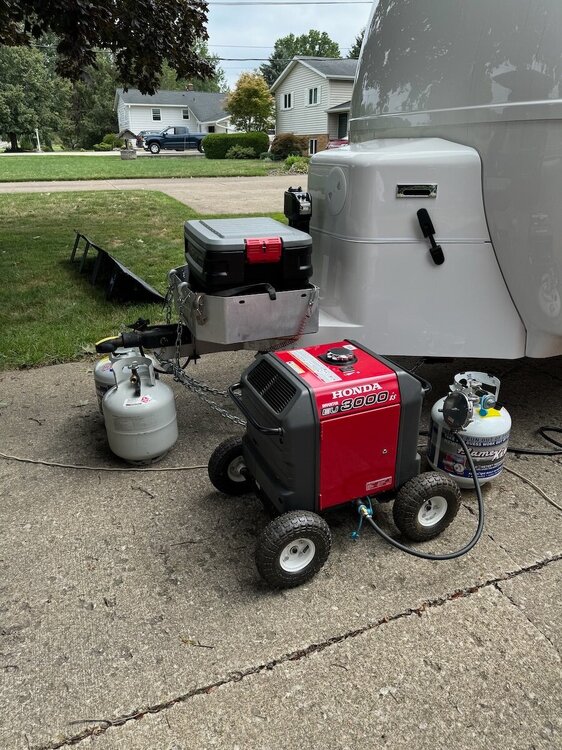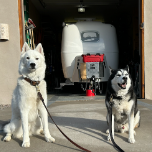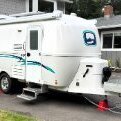Leaderboard
Popular Content
Showing content with the highest reputation on 08/09/2024 in all areas
-
Absolutely! We got by the first 36 hours on just the trailer's batteries alone. We'd also used the AC a couple of times, just to cool off and dry out. Not particularly hot at 80°, but 90% humidity was killer! The first night, I ordered a generator grounding plug and generator to RV 30A adaptor so that I could use the Honda generator. I'd never considered connecting it to the trailer before, so had no need for these. I'm glad I knew from prior posts on this forum that I needed a grounding plug, else I'd have been frustrated as to why it wouldn't charge. Amazon overnight shipping had them here at 7AM. Of course I only had the propane that was in the trailer (with one tank at 15%), and a little bit in a third tank that I've used all spring and summer for my fire pit. So after using up the latter, I swapped to the full Oliver tank, while I went to fill four more. (We had an empty from our son-in-law, who switched his grill to natural gas, and Deb had picked up two new ones at Costco earlier this summer to replace the out of date and nearly out of date tanks I already had.) About two hours after I returned from filling the tanks, the power came back on. At the height of the outage from four confirmed tornados, 627,000 Ohio customers were without power, with hundreds of poles needing replaced. First Energy was working double shifts with outside help from surrounding areas. But the estimate for complete restoration of power was August 14, so I wanted to make sure I was prepared. I just looked at their web site, and there are still 192,000 customers with no power 70 hours after the storm. If this had been January, we'd be in Florida, and our house would have broken pipes. While there is a lot of damage in the area, it could have been much, much worse!4 points
-
Our power came on about two hours after posting this. Spectrum is still working on telephone/TV/Internet, but we have our cellular router in the Oliver, so good on two out of three. And we only get junk on our landline, anyway.4 points
-
Glad to know you and Deb were able to adapt quickly to the situation and maintain some “normalcy”. Thanks for sharing your experience. This type situation is actually a real part of our decision to buy the Legacy Elite 2 with platinum lithium package. And it’s why I like to “driveway camp” regularly. During disaster events I want it to be second nature to use the Oliver to provide basic comfort and shelter while public systems are down. Having the tools/connections to use the Oliver to support other necessities at your home is difficult to throw together in the middle of a crisis. Setting up redundancy is very helpful.3 points
-
Great job making do in a tough situation. Mossey3 points
-
I have several recommendations, having spent weeks in that region this year: North Rim of GCNP is very nice, less congested, less commercial and there are plenty of NF boondocking sites that are within reach. From the Kaibab NF near the North Rim, you can also take day trips to places like Vermillion Cliffs, White Pocket (if you have OHV or hire a guide with capability), "The Wave" (be aware that tickets are required in advance -- for many of these highly desirable locations) and other places. Kanab UT is a great central location for camping before heading to Zion, as there are many things to see and do in that area: Pipe Spring NM, Dinosaur Tracks, Coral Pink Sand Dunes SP (where you could camp if you want hookups), as well as day trips from Kanab to Zion, Bryce, Red Cliffs and other sites. St George is much larger, and in my opinion it isn't as walkable as a city, whereas Kanab is entirely walkable. If you stay in Kanab, they have farmers markets two days a week, a great library, some interesting museums, good groceries, free fresh water and a very friendly Post Office where you can receive mail General Delivery (not all USPS will do that). I concur with others on trekking poles; take at least one with you. Learn and understand about driving in sand. Understand how the weather impacts the "dirt" (sand) roads. Plan your timing accordingly. As Spring marches on, and the dry weather extends into early summer, the sand becomes more treacherous. One Park Ranger warned me about trying to drive through the western section of GCNP (the section that is southwest of Pipe Spring NM) because "it's so dry that it's easy to get stuck and it can cost you $3,000 to get towed out". Don't pull over on the side of the road unless it's paved or you know that it's going to support your vehicle. I saw many 4WD vehicles mired in the sand, in late May and the first week of June. One area where I walked, the sand would rise up over the tops of my shoes with each footstep. It was like quicksand, but thankfully not quicksand. Once the monsoons hit, I was told, some areas of sand turn into mud that can be equally treacherous. This condition depends on the area, of course. You might call USFS offices in the region and ask -- I found them very helpful on information. You might switch around the order of your itinerary, to plan the sandy places earlier in your trip. That's my two cents. Have fun!3 points
-
48 hours after severe weather passed through northern Ohio, we, like 2-300,000 other residents, are without power. @firstenergyhome is busting their behind, but last posted number was 3200 downed lines to repair. So we’re making do with a hodgepodge of alternatives. We trashed what didn’t fit in the Oliver fridge or the truck fridge. We moved all frozen food to the chest freezer in the garage, which is being powered by the Oliver’s lithium batteries. The truck fridge is powered by swapping two Bluetti solar generators charged with the 200W panel or the Oliver. And the Honda generators charging the Oliver, so it can power everything else! 🤪 I just returned from filling four propane bottles to ensure days of power. At least we have air conditioning a stove, and a hot shower in the Oliver. It could be worse, at 90 degrees or sub-freezing and facing broken pipes.2 points
-
Those work great to verify a hot leg is live, but it seems like he has that already out to the outlets according to his circuit tester. Someone is going to have to use a multimeter and check voltage from the hot leg to the neutral at each connection point between the EMS to wherever the problem is. My guess is a bad neutral connection somewhere or a bad EMS itself.2 points
-
This is the area of testing where I like to use a non-contact voltage tester. Mossey2 points
-
I've been wondering... Some have reported that when upgrading to the Alcan spring it has increased ride height up to an inch and that there is more travel in the leaf spring. Should a replacement shock allow for the greater travel? The Monroe 555001 is the OEM spring. Monroe also has the 555025 model, which is the same overall yet slightly longer with greater stroke. I copied these specs from the 4statetrucks website, as Bulldog has aftermarket replacements for both models: Shock Specs 555001 555025 Compressed (in) 7.95 8.66 Extended (in) 11.97 13.35 Stroke (in) 4.02 4.69 Perhaps those who have installed Alcan springs can chime in? @Mountainman198 @MAX Burner @ScubaRx and @rideadeuce Did the shocks installed appear the correct length or would it allow for +3/4" in compressed length and +3/4"stroke be a better fit? Sure, the OEM length fit, but would +3/4" in stroke allow the slightly taller springs to perform without constraint? When I get the chance to make this upgrade, I would take before and after measurements on one side prior to ordering (let her sit on jacks stands a couple days to get the right part). I'm figuring 3/4" longer should be better. This has been a discussion on other TT forum websites. Stronger spring rate in the shock would also be preferred although Monroe does not list these specs. Either way I would choose Bulldog over the Monroe OEM brand. Bulldog describes their products as a "High Quality Aftermarket Replacement Part (Not OEM)." This is the ~+3/4" longer version: Bulldog HD RV Shock Absorber Replaces 555025 For Trailer Leaf Spring Retro Kit - 4 State Trucks2 points
-
I should mention one more thing. There is a scam artist that spoofs local towing companies. A friend was the victim of this when I was there. I recommend that you look up and save the correct phone number/s for local towing companies before venturing out, in case you need them. My friend paid $600 in advance over phone and then the company never showed up; it was a reputable company -- but he had 'looked up the number on google' and it was a spoofed phone number.2 points
-
2 points
-
I'm glad your power came back on Steve! I've seen other posts where our Ollies can also double up as a comfortable back up housing in a pinch!2 points
-
Bummer, but glad you have the Oliver for a base.2 points
-
Glad you're safe and powered again. We used our RV as a lifeboat for over a week after Hurricane Irene. Nice to have that option.1 point
-
In May before the rally, Oliver service replaced my springs, shocks, bearings and brakes. Jason did not mention any issues fitting the ALCAN springs I brought. I’m sure they used the stock Monroe shocks. I don’t notice my trailer sitting any higher, although I’m not sure I’d be able to discern a .5-.75” difference. After our summer trip through Colorado and Utah we didn’t notice any significant difference in the ride either. This should be a good setup as we start our second 100,000 miles. Mike1 point
-
I believe this bulldog shock is a direct replacement for the Monroe 555001 https://www.4statetrucks.com/bulldog-hd-shock-absorber-replaces-555001-19-0500000071 point
-
If you had said "OEM Leaf Spring" I would of course agree 100%. Its only got about 11 pounds of metal and most of us agree it is undersized/undersprung for OTT OE2 fleet wide use. The Dexter 2400 pound rated PB4 PR4 is a bunch more beefy spring than the OEM ones. It weighs about a pound less than the Alcan's. So to cast dispersion on ALL four leaf springs is a streach at best. It is also an exact fit without any of the user's reported challenges that have posted about the Alcan's. GJ1 point
-
Wish I could be there to help! Never witnessed a defect condition that would swap the hot and neutral readings. A faulty neutral makes some sense, but how does that happen when sitting at a campsite? Certainly replace the main 30A breaker. I would bypass it as a quick test, but I would not suggest this to anybody but a trained electrician. Too bad you do not have an inverter, as you could unplug from shore power and run on battery. I’m reading here daily to see if I can help, yet it’s difficult to troubleshoot virtually. Godspeed and wishes!1 point
-
Now I'm back to @Rivernerd's suggestion. Get a multimeter, or someone who knows how to use one, and follow the electricity's path until you find the problem. Test your home outlet, test the power at the end of the shoreline cable, test the power at the back of the shoreline connector in the trailer, test the power at the EMS input, test the power where it enters the circuit breaker box, test the power coming into the GFCI outlet, test at the AC, and keep going down the line. But this means working around live power and knowing how to use the meter correctly. You might be approaching professional assistance territory.1 point
-
An interesting vid on EVs and the enviromental cost associated with producing and owning an EV.1 point
-
I power my ev on sunlight. We rarely take it out of the county, but plenty of chargers for road trips, when we do. Not suitable for a tow vehicle, imo. Though others have the patience to do so. I don't. I think regulations have run ahead of the curve. Only tesla has really invested the big bucks in cross country charging stations, with quick charging capabilities. I can charge just about anywhere, depending on how long I want to sit idle. We're never going back to muscle cars, belching diesels, or low mpg/high emissions gassers,,so eventually, we'll have to figure it out. EVs, today, are best for local commuting, short runs, local deliveries . Which, honestly, is a high per centage of total miles driven for most .1 point
-
A few of the reasons we think owning an EV is not for us: We have no interest in an EV. The idea of someday being mandated by the government that we may have to comply and are forced to buy an EV is just not what we believe is American Freedom. 🇺🇸🇺🇸 Direct impact on the environment and health of workers mining lithium and other minerals. The draw on natural resources to mine lithium. The coal fired plants that power EVs is very real. Range anxiety due to the lack of charging infrastructure nationwide with no end in sight. Tremendous cost of installing this infrastructure on an ancient and completely vulnerable to attack power grid. (huge national security concern) Cost of installation of home charging ports for EVs. EV fires. Many fire departments are not equipped to deal with these fires and the hazardous fumes and what’s left over. Environmental impact. The cost of most EVs is completely out of reach for many American households. It’s been reported that insurance is much higher on EV’s mainly due to the extremely high cost of repairs if it can be repaired after an accident. Lack of qualified technicians at a body shop. Loss of mechanic jobs at existing dealerships. The huge cost of a replacement battery at some point in vehicle ownership. The accelerated depreciation of a used EV. Who wants yesterday’s EV tech? How Old Man Winter and extreme cold reduces the battery capacity. Many Canadians are already really unhappy with this and do not want EVs. EV’s are extremely heavy due to the battery weight and our roads pay the price. A road tax is being proposed in many states for EV owners since they don’t pay a fuel tax. Surely, at some point the government will automatically digitally tax EV owners on the miles driven and implement speed controls with electronic speed limiter in the name of safety. Some companies already implement digital control their on tractor trailers. Patriot🇺🇸1 point
-
Personally, I would swap from the South Rim of the GC to the North Rim. There is a world of difference.1 point
-
Be careful in how you plan for fall in Montana. Understand seasons in this neck of the woods can come and go in nearly a split second, and what most people think of the autumn months can be the dead of winter compared to their normal view of this season. Lived here for nearly half a century and have seen temps plunge to sub zeros mid September when the day before it was in the 70-80's or more. Colors start turning much sooner than other states too, usually by mid September and all but shot by the 3rd week of October if not sooner normally. Elevation plays a key role in this. The Flathead Valley area as well as Glacier will usually have color lasting a bit longer due to the lower elevations at base but again there is no guarantees other than to expect rapidly changing weather patterns. Yellowstone elevations are much higher as well and thus tend to end sooner. Hope this helps.1 point
-
Damn, I just tried to help @Ralph Mawyer with his question, and get piled on left and right! Im 5’7” and Deb is 5’1” She weighs less than me. We’re not average. I spent 45 years doing mechanical engineering, so I know numbers, too. Im out…1 point
-
Yep, we've discussed this before. Even back when you and I talked on the phone shortly after ordering our Oliver. I need to get it weighed to have some real numbers. The platform isn't the limiting factor, it is the US ratings. The rest of the world has substantially higher GVW than the US with an identical truck (not car - it is a body on frame construction beefier than most full size trucks.) Up to 8400 (vs 7385) with a simple rear spring change and up to 9900 pounds with a rear axle upgrade - all certified by the respective countries. But that doesn't do squat for me in the US, legally. I do know that a lot of of US Land Cruisers have been roaming the highways and mountains out west with GVWs of 8-9000 pounds for many years without legal ramifications. But it only takes once. The question has come up on the Land Cruiser forum whether the door sticker cargo capacity (based on tire loading) is legally binding when it contradicts the metal plate showing gross axle weights and gross vehicle weights. The discussion between some lawyers, law enforcement officers, and insurance agents came to the conclusion that the GVWR takes precedence if the tires are up to the requirements. A court would have to be the final arbiter, though. Delivered dry weight of my Land Cruiser was 5715 pounds; 1670 pounds less than the GVWR. There are no options, so that doesn't come into consideration. Taking out another 190 pounds of seats and roof basket should have started me off with 1860 pounds to play with. Eight quarts of oil, 24 gallons of fuel, and 12 quarts of water take up approximately 260 pounds of that, and our fat asses another 340. Tongue weight was 550 pounds in travel trim with full water and bikes, and your 65 pounds for the hitch. Fridge and shelves are about 150 pounds. That leaves around 500 pounds for stuff. So, do I have another 500 pounds in there? I don't know. That's why I need to weigh the truck, trailer, and both combined to get accurate numbers. I do know that I'm not going to get a different vehicle. I've said before, that I know this combination is a compromise, and one I'm willing to accept for my use.1 point
-
I bought a pickup almost 40 years ago, too. But then, I immediately turned it into a station wagon with a capper. I sold that about 25 years ago, and the two times I really needed one since, I rented it at Home Depot for $19.95. I haven't missed it at all, and replaced it with a subcompact turbo wagon. We didn't even have a pickup truck growing up on Grandpa's farm. Surprisingly, the Land Cruiser has a higher cargo capacity than some variations of Toyota's 1/2 ton Tundra. GVWR is 7385, max towing is 8100, max tongue weight is 750, and cargo capacity is 1360 pounds. And I've removed the 40 pound roof basket and 150 pounds of seats, before adding the fridge and drawers. The fridge was needed for the tiny trailer, and still comes in handy with the Oliver. Especially for preparing frozen food at home for extended trips. I get you on the tiny trailer. It's not for everyone, but we enjoyed it for seven years. It sure beat tent camping on the ground! But at 70, a little more comfort in the Oliver is very welcome.1 point
-
OK... You're boon docking in a remote area on BLM/Public land and you experience a critical medical emergency requiring local EMS response. A call to EMS on your commo device (either via local cell net, Starlink, PEPWave, SATPhone, HAM radio, or whatever) will require a hasty report with specific location information as accurately and efficient as possible. You may not have an accurate street address or may not know your grid/GPS coordinates. Even if grid/GPS coordinates are known, this data is a lengthy alphanumeric string of up to 17 characters which could easily be jumbled up or miscommunicated in the heat of the emergency, sending responders to the wrong location. Using the first 6 lines in a military-style "9-Line MEDEVAC" report is a good start to communicate for your EMS request. Line 1 of the 9-Line MEDEVAC format contains the most important data in the report - your location, expressed using either grid or GPS coordinates or a simple street address. Clearly, this critically important data should be quickly and accurately conveyed to the response team in a life-saving scenario. The problem is making this happen accurately from a remote location. An available free application has solved the problem - it's called, "what3words". While attending an amateur radio campout last week, "QuartzFest 2024", one of the EMS presentations introduced this application and how it can be used to more effectively vector-in a response team. At https://what3words.com/products/what3words-app you can learn what this app can do to accurately describe your location to an EMS team using only 3 random words. The developers of "what3words" have mapped the planet into discrete 3-meter grids, each of these grids is assigned 3 random words that never change. For example, sitting here in my living room, my "what3word" address is: "seamlessly.gossips.bottle". Should an emergency response be needed here, we could contact response personnel and pass along these 3 words to describe the location of the emergency. Provided the local EMS has access to the free app, many do, they'll be able to navigate their way to my living room. Responders across the country are using this app, as are companies like Amazon, Uber, and food delivery services, to bring their resources to a precise location without grid/GPS coordinates or inaccurate street addresses. The "what3words" address is compatible with many navigation apps and can be shared via text. Turns out, last year during the QuartzFest, an attendee experienced cardiac arrest. One of the HAMs contacted Quartzsite EMS, quickly communicated the specific "what3words" address of the patient's location and EMS deployed to that grid square using the app's navigation feature. We've got our family members up to speed on the "what3words" capabilities and would like to get the "word" out to the OTT RV community to consider using as part of their boon docking regimen. Stay safe out there! Cheers!1 point
-
There have been numerous posts in this forum about Oliver’s lithium battery systems—about their usefulness, limitations, and value with respect to cost. Despite reasonable arguments against it, a number of us have purchased the lithium package. Reasons for purchasing the option have included the ability to run the air conditioner (A/C) for short durations (like at highway rest stops), greater usable energy (more boondocking in cloudy weather without needing a generator), faster charging, and longer battery life. This post summarizes things I’ve learned over the last 6 months about the Xantrex/Lithium/Zamp system. This post might also be titled “Things I Wish I’d Known from the Start.” This summary is a work in progress. Hopefully, with your corrections and additions, this thread will be of use to others that have purchased the Lithionics option or are considering doing so. At the time of this writing, manuals and other information for the Lithionics batteries are in the Service Center Knowledge Base — see links at the end of this post. I assume at some point Lithionics information will be compiled with all of the other trailer manuals in Oliver University. Battery State of Charge A key component of the Lithionics system is the app that lets users monitor State of Charge (SOC) and voltage (see links below). The reliability of the SOC values (which describes the amount of energy remaining in the battery) depends on (1) maintaining SOC calibration and having (2) up-to-date Lithionics firmware. The SOC should be near 100% at 13.6 volts, and about 50% (+/- about 10%) at 13.2 volts. If this is not what you’re seeing on the Zamp controller, Xantrex remote, or Lithionics battery app, then something’s wrong. By way of example, a couple times we’ve experienced the SOC readings of 60% when the batteries were dead -- not good. Note that the voltage reading on the app while there is a load on the system (e.g., electric heater) is different than when there is no load; the “resting” voltage may be higher. SOC Calibration The SOC requires periodic calibration. According to the manual for the 130 Ah batteries, the SOC can be calibrated simply by charging the batteries to 14.4 volts. The manual also states that fully charging the batteries to 14.4 volts should be done at least once every two weeks for battery life. Get the 130-Ah battery manual from Lithionics using the links below; at the time of this writing, Oliver has the incorrect manual posted in the Knowledge Base). When charging with shore power, it is not always apparent that the batteries have reached 14.4 volts, because when charging, the batteries only stay at ~14.4 volts for a short while before dropping back to about 13.6 volts. You can verify that batteries have reached 14.4 volts by monitoring battery voltage using the Lithionics app during a charging event. If you are unsure that the batteries are reaching 14.4 volts, you can at least confirm that the Xantrex charger/inverter is set to charge to at least 14.4 volts in the Xantrex app (https://support.olivertraveltrailers.com/portal/en/kb/articles/xantrex-remote-bluetooth-pair-operation) and, under Settings, check the custom absorption voltage. Ours came from the factory set at 14.6 volts, which is sufficiently high to get the batteries to 14.4 volts. Lithionics Firmware At least some of us that picked up our trailers in spring or early summer have batteries with outdated firmware. As I understand from Lithionics, more recent firmware versions have an improved SOC algorithm (our initial SOC readings were unreliable). You can check firmware version with the Lithionics app by clicking on a battery, then clicking on the settings “sprocket” in the upper right side, and then clicking on firmware. Our battery came with firmware version 1.0.05; I’ve recently updated to 1.0.07 by clicking on flash firmware. This has to be done with your phone in close proximity to the battery, and has to be done separately for each battery. Updating firmware comes with a “…this is a critical operation…” warning; you might want to check with Oliver or Lithionics if you have any questions about doing this. Has updating firmware improved our SOC readings? I’m not sure yet, but I think so. So far, the readings seem more reliable, but I’m still testing. SOC Calibration by Cycling A Lithionics rep told me that the SOC can be calibrated by “cycling” the batteries, and that this should be done every two months. Cycling consists of discharging the batteries to reserve voltage (e.g., ~12.1 volts) and then charging to 14.4 volts. However, the rep could not point to written documentation supporting this form of calibration. As the batteries support more partial cycles than full cycles (see graph below), calibrating by simply charging to 14.4 volts (assuming this effectively calibrates the SOC) seems better for battery life. Lithionics batteries will not charge from tow vehicle The standard 7-pin connection from tow vehicle to trailer cannot be used for charging the Lithionics batteries. Charging the batteries from the TV requires a DC to DC charger, which is an aftermarket installation. For more discussion on this, search for John Davies’ Redarc DC-to-DC charger installation description. Batteries Turn Off Twice now one or two of the three 130-Ah batteries have turned off when reaching low voltage (which happened because we were relying on incorrect SOC values). The SOC readings themselves looked OK, but the voltage did not correspond with SOC. The battery State in the Lithionics app reads “Off” for each battery when it is off. There is no flag on the Zamp or Xantrex control panel that alert the user to one or two batteries being off. The lesson (at least for me): monitor all three batteries, not just one, and note the Current, Power, State, and Status Code settings. If one or more batteries are off, turn the battery(ies) back on, and fully charge to 14.4 volts. Inverter Noise The Xantrex charger/inverter can be noisy charging the batteries with shore power (I’ve measured 60-64 decibels in the cabin when batteries are charging, and about 72 decibels adjacent to the inverter). The noise comes from (1) the charger/inverter fan and (2) the way in which the inverter is mounted (the fiberglass wall to which the inverter is mounted propagates noise into the cabin). The noise can be masked by turning on the A/C. Alternatively, the noise level can be reduced somewhat by lowering the charger current. In the Xantrex app, go to settings, and change the Charger Current from, for example, 100 amps to 30 amps. This will reduce fan noise. It will obviously take longer to charge the batteries with lower current. If you would like to be connected to shore power (to run an electric heater or the A/C, for example), but not charge the batteries (to avoid keeping them fully charged for long periods of time, or to reduce inverter noise) you can set the charger ignition control in the Xantrex app settings to “auto-on” (thanks to NCEagle for figuring this one out). In this mode shore power energizes the 110 outlets, the A/C, and the fridge, but does not charge the batteries. Turn the charger ignition control “off” to resume charging batteries with shore power. There are likely ways of re-mounting the inverter so that noise does not propagate into the cabin, with either a different mounting location or perhaps mounts using rubber bushings. Has anyone tried this yet? Xantrex Communication Errors Too often, I’ve gotten “Code 20” communication errors on the Xantrex remote panel. This can be resolved by pushing the red button on the 300A breaker under the streetside bed, waiting for at least 30 minutes, and then pressing in the little red flag on the breaker. Yes, this is a pain (I wish this breaker were more accessible), but it usually resolves the issue. Leaving the Xantrex inverter on battery mode for 25 hours or more will result in the Code 20 communication error. The time limit can be changed in the Xantrex app, but cannot be lengthened to more than 25 hours. As long as the inverter has not timed out, turning the inverter off and then on again at the remote panel resets the 25-hour time-limit clock. Battery Storage Lithionics provides guidance for storing the lithium batteries (see link below). Long term storage can include lowering the SOC to about 50%. Discharging to the appropriate SOC can be accomplished by turning on an electrical load (e.g., A/C or space heater) while in battery mode and monitoring frequently. Theoretically one could set the inverter cutoff voltage (in the inverter app, under settings), to something like 13.2 volts, but the highest cutoff-voltage option is 12.8 volts. Lithionics recommends keeping a log of SOC and voltage readings prior to and after storage for warranty purposes. ------------------------ Hope this helps. Again, please correct any errors that you see, and please add your observations and tips. Fritz ------------------------------------------ Relevant Links Lithionics battery app: https://support.olivertraveltrailers.com/portal/api/kbArticles/386680000012415191/locale/en/attachments/lpqvx861bbc9c842d48f7995281b07d0a193d/content?portalId=edbsnfe5dceb1ade7571879ff200cb63e14a94b62f48e3338c31a6401acd00130b0bc&inline=true). Lithionics battery manual: At the time of this writing, the Oliver Knowledge Base has links to Lithionics manuals for 125 Ah and 320 Ah batteries. However, our LE2 has three 130 Ah batteries as part of the 390-Ah package, and the manuals for the 125-AH batteries and the 130-Ah batteries are not the same. A manual for the 130 Ah battery can be found on the Lithionics website: https://lithionicsbattery.com/wp-content/uploads/2018/12/12V130-G31LRBM8-Battery-User-Guide-R1.pdf. Lithionics Storage Procedure https://support.olivertraveltrailers.com/portal/api/kbArticles/386680000012415191/locale/en/attachments/lrotz3ebee5a7020f42a58eb0d4db18a41356/content?portalId=edbsnfe5dceb1ade7571879ff200cb63e14a94b62f48e3338c31a6401acd00130b0bc&inline=true Lithionics FAQs https://support.olivertraveltrailers.com/portal/api/kbArticles/386680000012415191/locale/en/attachments/lrotz0edc34bc92ef4dce941bbb7f3f2d89db/content?portalId=edbsnfe5dceb1ade7571879ff200cb63e14a94b62f48e3338c31a6401acd00130b0bc&inline=true Xantrex Remote Bluetooth Pairing and Operation https://support.olivertraveltrailers.com/portal/en/kb/articles/xantrex-remote-bluetooth-pair-operation1 point
-
I don't want to know ANY of this technical stuff. I just want the darn thing to work. If I have to learn all this, I want my money back.1 point
-
Recent Achievements






.thumb.jpg.e34bf01ef7f7d5e99ad31856d45afbeb.jpg)













